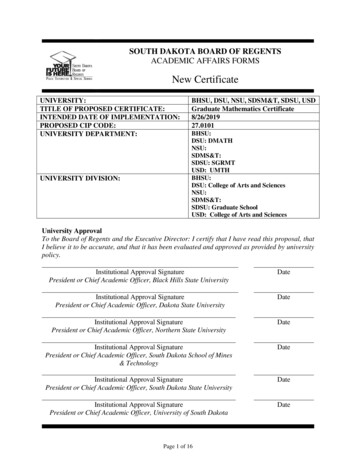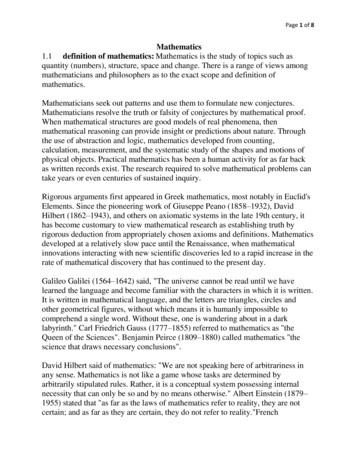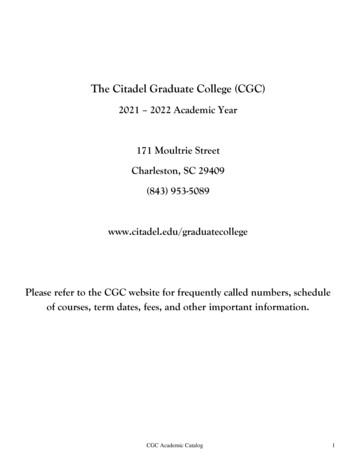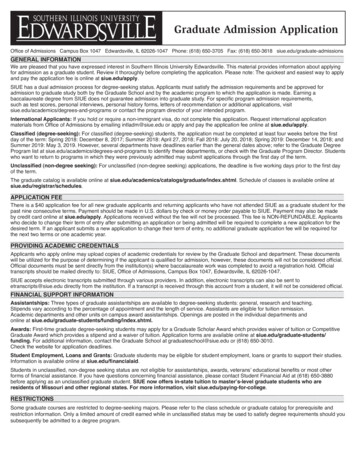
Transcription
SOUTH DAKOTA BOARD OF REGENTSACADEMIC AFFAIRS FORMSNew CertificateUNIVERSITY:TITLE OF PROPOSED CERTIFICATE:INTENDED DATE OF IMPLEMENTATION:PROPOSED CIP CODE:UNIVERSITY DEPARTMENT:UNIVERSITY DIVISION:BHSU, DSU, NSU, SDSM&T, SDSU, USDGraduate Mathematics Certificate8/26/201927.0101BHSU:DSU: DMATHNSU:SDMS&T:SDSU: SGRMTUSD: UMTHBHSU:DSU: College of Arts and SciencesNSU:SDMS&T:SDSU: Graduate SchoolUSD: College of Arts and SciencesUniversity ApprovalTo the Board of Regents and the Executive Director: I certify that I have read this proposal, thatI believe it to be accurate, and that it has been evaluated and approved as provided by universitypolicy.Institutional Approval SignaturePresident or Chief Academic Officer, Black Hills State UniversityDateInstitutional Approval SignaturePresident or Chief Academic Officer, Dakota State UniversityDateInstitutional Approval SignaturePresident or Chief Academic Officer, Northern State UniversityDateInstitutional Approval SignaturePresident or Chief Academic Officer, South Dakota School of Mines& TechnologyDateInstitutional Approval SignaturePresident or Chief Academic Officer, South Dakota State UniversityDateInstitutional Approval SignaturePresident or Chief Academic Officer, University of South DakotaDatePage 1 of 16
1. Is this a graduate-level certificate or undergraduate-level certificate (place an “X” in theappropriate box)?Undergraduate Certificate Graduate Certificate 2. What is the nature/purpose of the proposed certificate?Dakota State University in collaboration with all of the Universities in the SD BOR system isproposing teaching six graduate math content courses online to high school mathematics teachers(as well as to others capable of completing graduate math courses) that currently hold a mastersdegree or are enrolled in a masters degree program so they can become concurrent dual creditinstructors and earn a Graduate Math Certificate and an Advanced Graduate Math Certificate.The goal is to increase the number of high school teachers that can serve as concurrent dualcredit instructors and decrease the number of high school students taking online classes, inparticular online college algebra classes. The first three graduate math courses proposed in thisrequest will earn the student a Graduate Mathematics Certificate.The HLC Guidelines s 2016 OPB.pdf)specifically address the qualifications of dual credit instructors (“Determining MinimallyQualified Faculty in the Context of Dual Credit”). Dual credit instructors are expected to meet thesame faculty qualifications as university instructors. Those expectations include a Masters Degreeand at least 18 graduate content credits in mathematics using the credentials criteria. To meet theseguidelines participants would need to complete both the Graduate Math Certificate and theAdvanced Graduate Math Certificate to earn the 18 graduate math content credits.There are several programs across the country that have been created in an effort to provide amechanism for high school teachers to earn the credentials necessary to meet the HLC guidelinesto be concurrent dual credit instructors. Below are a few examples, but there are many more thatcome up in an internet search.Indiana University East mathematics.php)offers a program titled “Online Graduate Certificate in Mathematics.” The following is theprogram description from the webpage linked above.“The Graduate Certificate in Mathematics offers graduate level education in mathematics.The program is intended for students who wish to prepare for admission to graduate studiesat another institution, or for holders of a Masters degree in a discipline other thanmathematics, who teach mathematics classes at the community college level. The programis also open to high school teachers who wish to obtain the qualification to teach AdvancedPlacement courses.”The goal of the proposed program is very similar in nature which is to provide credentials toprogram completers to be concurrent dual credit mathematics teachers.In addition to requiring a total of six classes (18 credit hours), they also require students tocomplete one course from the areas of analysis, algebra, topology/geometry, applications andprobability-statistics.Page 2 of 16
There are other programs which are similar in nature and below is a list of a few of theseprograms with links to their programs.Indiana University Wesleyan - duatecertificate-math/requirementsGeorge Washington University - emathematicsVillanova University - atics/academicprograms/certificate.htmlTexas Tech University - thematics/The common theme for these certificate programs is bluntly stated on the Texas Tech certificatepage: “The Graduate Certificate in Mathematics is an online 18-hour certificate designed foranyone with a master's or doctoral degree who wants to increase mastery of mathematics,particularly in-service teachers who desire to teach dual credit in high school or teach at ajunior college.”3. Provide a justification for the certificate program, including the potential benefits tostudents and potential workforce demand for those who graduate with the credential.1There are very few math teachers that have 18 graduate credit hours of math content courses anda master’s degree. As a result, students that take Dual Credit classes in mathematics either go toa state university, take them online or for some have a university faculty member go to theirschool. Most SD students either take Dual Credit courses online or they don’t participate in theDual Credit program offered to South Dakota High School students. This program wouldenhance the credentials of program completers which would as a result increase the educationopportunities afforded to their students. This is a workforce development proposal.While the Department of Education changes have created a larger pool of teachers that arecertified to teach high school mathematics courses, it has not enhanced the pool of high schoolteachers that have the credentials to be concurrent dual credit instructors so their high schoolstudents can earn college credit from courses offered within the high school. That is, moreteachers can become endorsed in the state of South Dakota to teach high school mathematics(any teacher that passes the middle school math praxis exam is endorsed to teach lower levelhigh school mathematics), however there are very few high school mathematics teachers thathave both a master’s degree and 18 graduate math content credits which is an HLC guideline forbeing a dual credit instructor. Although DSU has been contacted by several schools interested inoffering a concurrent dual credit college algebra course, we have yet to be contacted by a highschool that has a high school math teacher with 18 graduate credit hours of math contentcoursework. This is a workforce development proposal.In the August 1, 2014, a blog from the Association of School Boards of South n/) titled “Plenty of Concern over Teacher Shortages”it was reported that 29 of the 62 spring mathematics teaching jobs in the state were still vacant on1For workforce related information, please provide data and examples; data sources may include but are not limitedto the South Dakota Department of Labor, the US Bureau of Labor Statistics, Regental system dashboards, etc.Page 3 of 16
May 28th. Mathematics is identified as a discipline in 2016-2017 having teacher shortages perinformation from DOE, SD, https://doe.sd.gov/oatq/shortageareas.aspx. The June 18, 2014 blog -fill/) reported that “75 percent of superintendentsresponding to the survey believed the teaching applicant pool was inadequate.”In recent years there have been certification rule modifications which has created a larger pool ofteachers that are certified to teach high school mathematics. The first of those rule changesallowed secondary math education majors to take the middle school Math Praxis exam and themost recent changes removed the Praxis exam altogether for applicants with a content major inmathematics.This is a program that would enhance the qualifications of the participating high schoolmathematics teachers.4. Who is the intended audience for the certificate program (including but not limited to themajors/degree programs from which students are expected)?The Graduate Mathematics Certificate and the Advance Graduate Mathematics Certificate areprograms (each has 9 graduate math credits) designed for current high school mathematicsteachers that are either enrolled in or have completed a master’s degree that would like tobecome concurrent dual credit math instructors and need the 18 credit hours of gradate mathcontent to meet HLC guidelines.5. List the courses required for completion of the certificate in the table below (if any newcourses are proposed for the certificate, please attach the new course requests to this formList the courses required for completion of the certificate in the table below (if any newcourses are proposed for the certificate, please attach the new course requests to thisform):2To earn the graduate math certificate and the advanced graduate math certificate, a student wouldneed to complete 18 graduate credit hours in mathematics meeting the HLC guidelines for being adual credit math instructor (provided the student already has a master’s degree). The onlyrequirements in the program are that all courses used to meet the certificate requirements are mathor stat prefixed courses and that there is at least one analytic and one abstract course in the collectionof three courses (nine credits). Also, one course from a non-SDBOR University may be substituted.Note, all courses must be math or stat content courses so that students who complete the introductorygraduate math certificate and the advanced graduate math certificate meet the HLC guidelines to bedual credit instructors. Courses cannot be used to fulfill the requirements of both the Graduate MathCertificate and the Advanced Graduate Math Certificate.PrefixNumberCourse Title(add or delete rows as needed)Abstract Component: choose one of the followingMATH513Abstract Algebra IMATH514Abstract Algebra IIMATH536Number Theory and Cryptography2CreditHours3New(yes, no)NoNoNoRegental system certificate programs typically are a subset of the curriculum offered in degree programs, includeexisting courses, and involve 9-12 credits for completion. Deviations from these guidelines require justification andapproval.Page 4 of 16
PrefixNumberCourse Title(add or delete rows as needed)MATH537Cryptography and CodesMATH561GeometryMATH713Advanced Algebra IMATH714Advanced Algebra IIMATH716Theory: Algebraic StructuresAnalytic Component: choose one of the followingMATH523Advanced Calculus IMATH524Advanced Calculus IIMATH571Numerical AnalysisMATH622Difference EquationsMATH625Advanced CalculusMATH721Complex VariablesMATH723Real Variables IMATH724Real Variables IIMATH741Measure and ProbabilityMATH751Applied Functional AnalysisGraduate Math Elective:Any MATH or STAT content course 500 level or higher not used asthe Abstract or Applied Mathematics course for this Certificate.SubtotalCreditHours33New(yes, no)NoNoNoNoNoNoNoNoNoNoNoNoNoNoNoNo9These graduate math courses are taught by SDBOR Universities and will enhance the contentknowledge of participating teachers and give them experience using abstract knowledge in real worldscenarios.6. Student Outcome and Demonstration of Individual Achievement. 3A. What specific knowledge and competencies, including technology competencies, will allstudents demonstrate before graduation? The knowledge and competencies should bespecific to the program and not routinely expected of all university graduates.Individual Student Outcomes:Content Knowledge: Demonstrate depth and breadth of content knowledge in a core area of mathematics.Critical Thinking: Read, analyze, write and present mathematical arguments with clarity.Inquiry Analysis: Research current mathematical practices/theorems and communicate findings.B. Complete Appendix A – Outcomes using the system form. Outcomes discussed belowshould be the same as those in Appendix A.7. Complete the following charts to indicate if the university intends to seek authorization todeliver the entire certificate at any off-campus location (e.g., UC Sioux Falls, Capital3Board Policy 2:23 requires certificate programs to “have specifically defined student learning outcomes.”Page 5 of 16
University Center, Black Hills State University-Rapid City, etc.) or intends to seekauthorization to deliver the entire certificate through distance technology (e.g., as an online program)?4Yes/NoOff-campusIntendedStart DateClick hereto enter adate.If Yes, identify delivery methodsIntendedStart Date8/15/2019NoYes/NoDistance DeliveryIf Yes, list location(s), including the physicaladdressYes018 Internet Synchronous8. Additional Information: Additional information is optional. Use this space to providepertinent information not requested above. Limit the number and length of additionalattachments. Identify all attachments with capital letters. Letters of support are not necessaryand are rarely included with Board materials. The University may include responses toquestions from the Board or the Executive Director as appendices to the original proposalwhere applicable. Delete this item if not used.Note – the HLC requirement to be a dual credit instructor is to have a master’s degree and if themasters degree is not in the content area then the instructor must have 18 graduate content creditsin the discipline being taught which is why we have requested two 9-credit graduate mathematicscertificates.4The accreditation requirements of the Higher Learning Commission (HLC) require Board approval for a universityto offer programs off-campus and through distance delivery.Page 6 of 16
Appendix AIndividual Student Outcomes and Program CoursesList specific individual student outcomes—knowledge and competencies—in each row. Label each column with acourse prefix and number. Indicate required courses with an asterisk (*). Indicate with an X the courses that willprovide the student with an opportunity to acquire the knowledge or competency listed in the row. All students shouldacquire the program knowledge and competencies regardless of the electives selected. Modify the table as necessaryto provide the requested information for the proposed program.Individual Student Outcomes and Program CoursesList specific individual student outcomes—knowledge and competencies—in each row. Labeleach column with a course prefix and number. Indicate required courses with an asterisk (*).Indicate with an X the courses that will provide the student with an opportunity to acquire theknowledge or competency listed in the row. All students should acquire the program knowledgeand competencies regardless of the electives selected. Modify the table as necessary to providethe requested information for the proposed program.AbstractAnalyticIndividual Student OutcomeElectiveComponentComponentContent Knowledge: Demonstrate depth andbreadth of content knowledge in a core area ofmathematics.Critical Thinking: Read, analyze, write andpresent mathematical arguments with clarity.Inquiry Analysis: Research current mathematicalpractices/theorems and communicate findings.Page 7 of 16XXXXXXXXX
South Dakota Board of RegentsCollaborative Graduate Math Certificates Administration Guidelines1. Collaborative PurposeThe ability to offer Graduate Certificates in Mathematics (Graduate Math Certificate and AdvancedGraduate Math Certificate) for students in South Dakota is of critical interest to the South DakotaBoard of Regents (SDBOR). As a result, the SDBOR has established a framework within bothpolicy and guidelines to encourage institutions to identify collaborative opportunities that will allowfor the sharing of faculty resources, expertise and infrastructure to improve efficiencies and reduceunnecessary duplication. Specifically Academic Programs - Certificates5 and Section Size6 policiesand guidelines have created exemptions to foster an environment for faculty across institutions tocollaborate on common programs. Within this context, the purpose of the Collaborative Certificatesin Mathematics is to provide a framework for the common delivery of graduate math courses for thegraduate math certificates (both face-to-face and via distance) by Black Hills State University,Dakota State University, Northern State University, South Dakota School of Mines, South DakotaState University, and the University of South Dakota.2. Partners & Institutional Leads2.1. Participating Institutions: Black Hills State University, Dakota State University, NorthernState University, South Dakota School of Mines, South Dakota State University, and theUniversity of South Dakota.2.2. Each participating institution will identify a designated institutional representative appointedby the Chief Academic Affairs Officer who will be responsible for coordinating activitieswith other partner institutions pursuant to the terms of this agreement.2.3. Changes to the agreement may be made from time-to-time and must be agreed upon by themajority of designated institutional representatives.3. Common Learning Outcomes3.1. Aligned with the purpose of graduate programs, 2A of Policy 2:29 – Definition of Creditsand Institutional Requirements, the graduate certificates in mathematics learning outcomesfocus on “an in-depth study of the major field that relies upon interactions both in and out ofthe classroom and is not just a collection of courses” which “ensures that the student developsa mentoring relationship with the faculty” of the program.3.1.1. The participating institutions in the collaborative will assess a common set oflearning outcomes to ensure greater coordination across the courses delivered tostudents in the graduate math certificates. The designated learning outcomesinclude:3.1.1.1. Content Knowledge: Demonstrate depth and breadth of contentknowledge in a core area of mathematics.3.1.1.2. Critical Thinking: Read, analyze, write and present mathematicalarguments with clarity.3.1.1.3. Inquiry Analysis: Research current mathematical practices/theoremsand communicate findings.3.1.2. Participating institutions shall have the flexibility to identify and assess additionallearning outcomes that align with institutional priorities, but deviations from thethree learning outcomes outlined in 3.1.1 of this agreement must be approved bythe majority of the participating members of the consortium.3.2. Assessment Strategies5Section 1 of the New Certificate Program Guidelines establishes that certificate programs can “include coursesoffered collaboratively with another Regental university.”6Section 2.6 of current AAC Section Size Guidelines established that “Collaborative courses with a selectedinstructional method code that result from a shared program agreement among Regental institutions shall beexcluded.”Page 8 of 16
3.2.1. Participating institutions agree to develop similar types of assessments for eachcourse component in the certificate programs.3.2.2. The Math Discipline Council will create and maintain rubrics for the CriticalThinking and Inquiry Analysis learning outcomes that faculty are encouraged touse when evaluating assessments aligned to these outcomes.3.2.3. Review of the rubrics for Critical Thinking and Inquiry Analysis will be a standingagenda item for the MDC and any modifications to the rubrics must be approvedby the MDC.3.2.4. The Math Discipline Council will require that all courses that satisfy at least oneof the three course components of each graduate math certificate program has awritten project that requires students to research a topic and that the rubricmaintained by the MDC for inquiry analysis is used to evaluate these writtenprojects.3.3. Participating institutions agree that program completers that have also earned a mastersdegree have met the requirements to be concurrent dual credit mathematics instructors thusproviding “pathways to further education and employment” which is part of section 2 of theSouth Dakota Board of Regents Certificate Guidelines.4. Curriculum4.1. A common curriculum will be used by participating institutions for the graduate mathcertificate and the advanced graduate math certificate. Curriculum modifications to thegraduate math certificates must originate and be approved by the Math Discipline Councilbefore moving through the traditional curriculum cycle.4.2. The curriculum in the Graduate Math Certificate and the Advanced Graduate MathCertificate shall include:4.2.1.An abstract graduate math course.4.2.2.An analytic graduate math course.4.2.3.A graduate math elective course.4.3. Faculty advisors and program administrators have the authority to substitute an appropriategraduate mathematics and/or graduate statistics courses for any of the courses in the graduatemath certificate and the advanced graduate math certificate from an accredited university.4.4. At least two of the three courses required to earn the graduate math certificate and theadvanced graduate math certificate must be taken in the SD BOR Regental system. No coursecan be used to satisfy the course requirements for the graduate math certificate and theadvanced graduate math certificate.4.5. Students can earn the Advanced Graduate Math Certificate only if they have previouslyearned the Graduate Math Certificate.4.6. Shared Curriculum Matrix4.6.1.Beginning with the Fall 2019 term a five year shared curriculum matrix will bedeveloped by the institutional leads which will identify the graduate math coursesbeing offered by participating institutions (see appendix B).4.6.2.The rotation will include the delivery of courses offered during the Fall, Springand Summer terms. Each participating institution will offer graduate math coursesin the rotation and the rotation will ensure that students may successfully completethe certification requirements online in a timely fashion.5. Textbook & Instructional Resources5.1. Consistent with BOR Policy 1:11 – Academic Freedom and Responsibility Institutionalfaculty are given academic freedom to select textbook and instructional materials they deemappropriate for the upper division coursework delivered through the consortium.5.2. Online graduate math courses will go through the SD BOR quality matters review for onlinecourses and meet the criteria contained in the South Dakota Online QA Rubric.5.3. Online courses supporting the graduate math certificates will have a course site in D2L thatwill be used to deliver course materials and post student grades.Page 9 of 16
6. Funding Model6.1. Tuition revenue generated by the institution offering the course will remain with thatinstitution.6.2. Students pursuing the completion of the graduate math certificates at a main campuslocation, will be assessed the off-campus rate.6.3. Students not enrolled in coursework at a main campus location will be assessed theestablished off-campus rate approved by the SDBOR.Page 10 of 16
Appendix AGraduate Math Certificate9 graduate math creditsRequired Courses (6 hours):Abstract Component: 3 credit hours.The following courses taught in the BOR system meet this requirementMATH 513MATH 514MATH 536MATH 537MATH 561MATH 713MATH 714MATH 716Analytic Component: 3 credit hours.The following courses taught in the BOR system meet this requirementMATH 523MATH 524MATH 571MATH 622MATH 625MATH 721MATH 723MATH 724MATH 741MATH 751Elective Requirements (3 hours):Any MATH or STAT content course 500 level or higher not used as the Abstract or Applied Mathematicscourse for this Certificate.Page 11 of 16
Advanced Graduate Math Certificate:9 graduate math creditsRequired Courses (6 hours):Abstract Component: 3 credit hours.The following courses taught in the BOR system meet this requirementMATH 513MATH 514MATH 536MATH 537MATH 561MATH 713MATH 714MATH 716Analytic Component: 3 credit hours.The following courses taught in the BOR system meet this requirementMATH 523MATH 524MATH 571MATH 622MATH 625MATH 721MATH 723MATH 724MATH 741MATH 751Elective Requirements (3 hours):Any MATH or STAT content course 500 level or higher not used as the Abstract or Applied Mathematicscourse for this Certificate.The Advanced Graduate Math Certificate can be earned only if the student has already earned theGraduate Math Certificate and no course used to meet the requirements in the Graduate MathCertificate can be used to meet the requirements in the Advanced Graduate Math Certificate.Page 12 of 16
Appendix BGraduate Math Certificate Learning OutcomesContent Knowledge: Demonstrate depth and breadth of content knowledge in a core area of mathematics.Critical Thinking: Read, analyze, write and present mathematical arguments with clarity.Inquiry Analysis: Research current mathematical practices/theorems and communicate findings.Page 13 of 16
Appendix CApproved Course Rotation for Online & On-Campus CoursesFall Semesters:Fall 19Fall 20Fall 21Fall 22Fall 23BHSUDSUNSUMATH 561(online)MATH 513(online)MATH 537(online)MATH 537(online)MATH 512(on campus*)MATH 561(online)MATH 537(online)MATH 513(online)MATH 561(online)MATH 537(online)MATH 537(online)MATH 512(on campus*)MATH 571 (on campus)MATH 625 (on campus)STAT 601 (online)MATH 513(on campus*)MATH 524(on campus*)MATH 723(on campus*)MATH 571 (on campus)MATH 625 (on campus)STAT 601 (online)MATH 513(on campus*)MATH 524(on campus*)MATH 723(on campus*)MATH 571 (on campus)MATH 625 (on campus)STAT 601 (online)MATH 513(on campus*)MATH 713(on campus*)SDSMTSDSUUSDMATH 571 (on campus)MATH 625 (on campus)STAT 601 (online)MATH 513(on campus*)MATH 713(on campus*)Page 14 of 16MATH 571 (on campus)MATH 625 (on campus)STAT 601 (online)MATH 513(on campus*)MATH 524(on campus*)MATH 3(on campus*)
Spring Semesters:Spring 19Spring 20BHSUDSUMATH 536(online)MATH 536(online)NSUSpring 21Spring 22Spring 23MATH 523(online)MATH 513(online)MATH 523(online)MATH 536(online)MATH 536(online)MATH 536(online)MATH 741 (on campus)STAT 602 (online)MATH 514(on campus*)MATH 523(on campus*)MATH 721(on campus*)MATH 724(on campus*)MATH 741 (on campus)STAT 602 (online)MATH 714(on campus*)MATH 523(on campus*)MATH 571(on campus*)MATH 512(on campus*)SDSMTSDSUUSDMATH 741 (on campus)STAT 602 (online)MATH 523(on campus*)MATH 571(on campus*)MATH 741 (on campus)STAT 602 (online)MATH 514(on campus*)MATH 523(on campus*)MATH 721(on campus*)MATH 724(on campus*)MATH 741 (on campus)STAT 602 (online)MATH 714(on campus*)MATH 523(on campus*)MATH 571(on campus*)Page 15 of 16
Summer Sessions:Summer 19Summer 20Summer 21Summer 22Summer 23BHSUDSUMATH 622 (online)MATH 622 (online)NSUSDSMTSDSUSTAT 541 (online)STAT 600 (online)STAT 541 (online)STAT 600 (online)MATH 523 (online)STAT 541 (online)STAT 600 (online)STAT 541 (online)STAT 600 (online)MATH 523 (online)STAT 541 (online)STAT 600 (online)USD*Can be taught through DDN for students unable to come to the on campus section.Note that at least two courses meeting the algebra component, two courses meeting the analysis component and at least two additional courses are currentlyin the online rotation ensuring the opportunity for timely completion of both certificates. Additional classes added to the table will add flexibility forstudents.Page 16 of 16
The common theme for these certificate programs is bluntly stated on the Texas Tech certificate page: " The Graduate Certificate in Mathematics is an online 18-hour certificate designed for anyone with a master's or doctoral degree who wants to increase mastery of mathematics,










